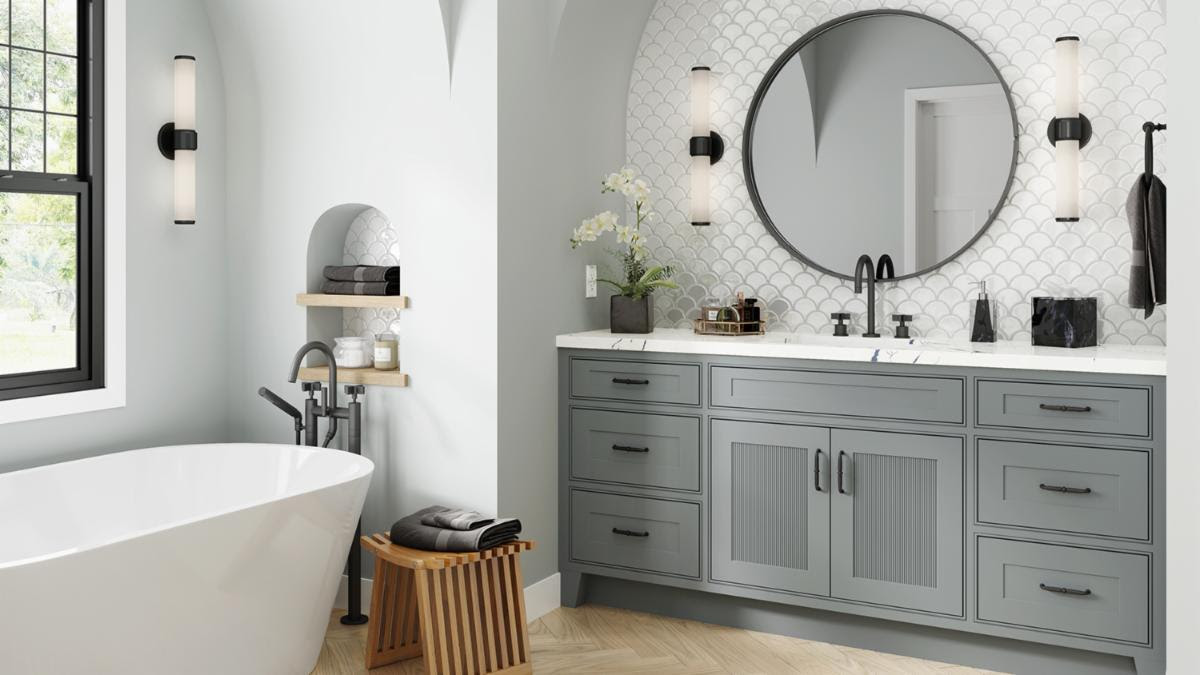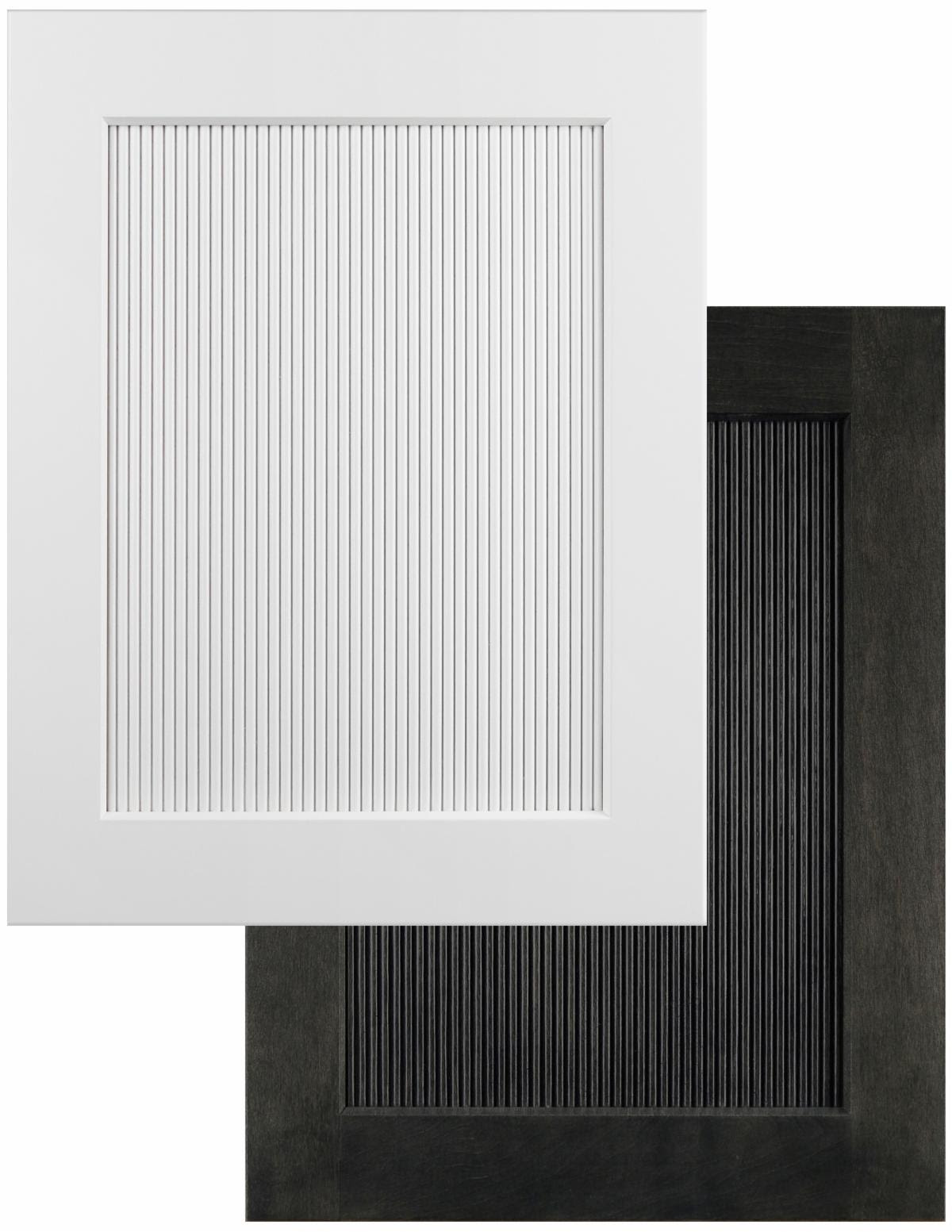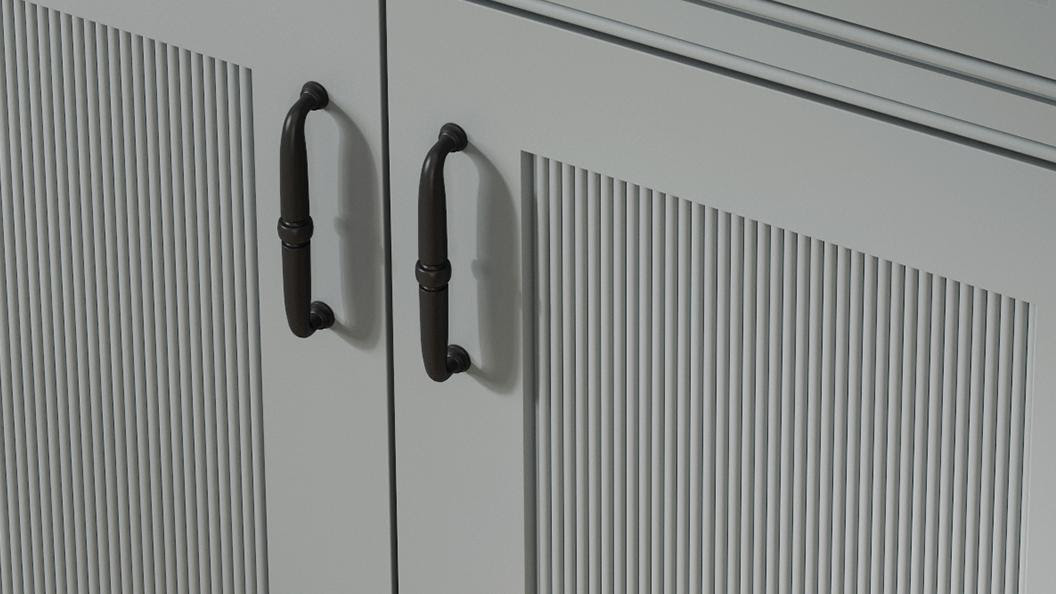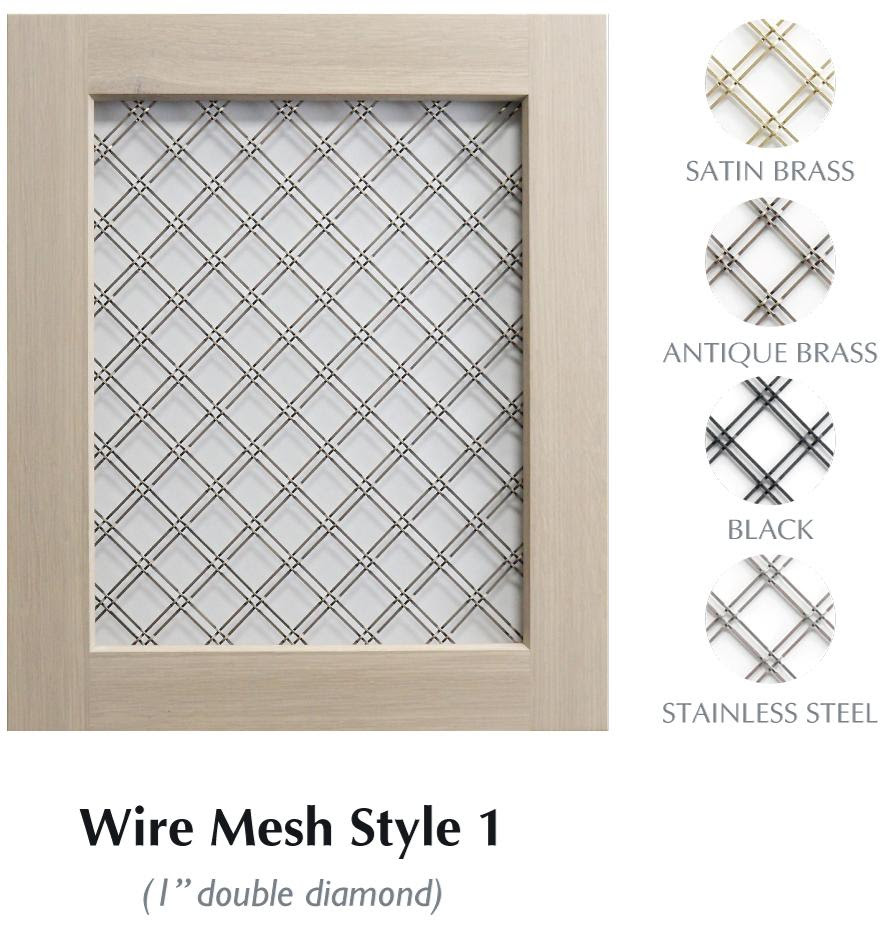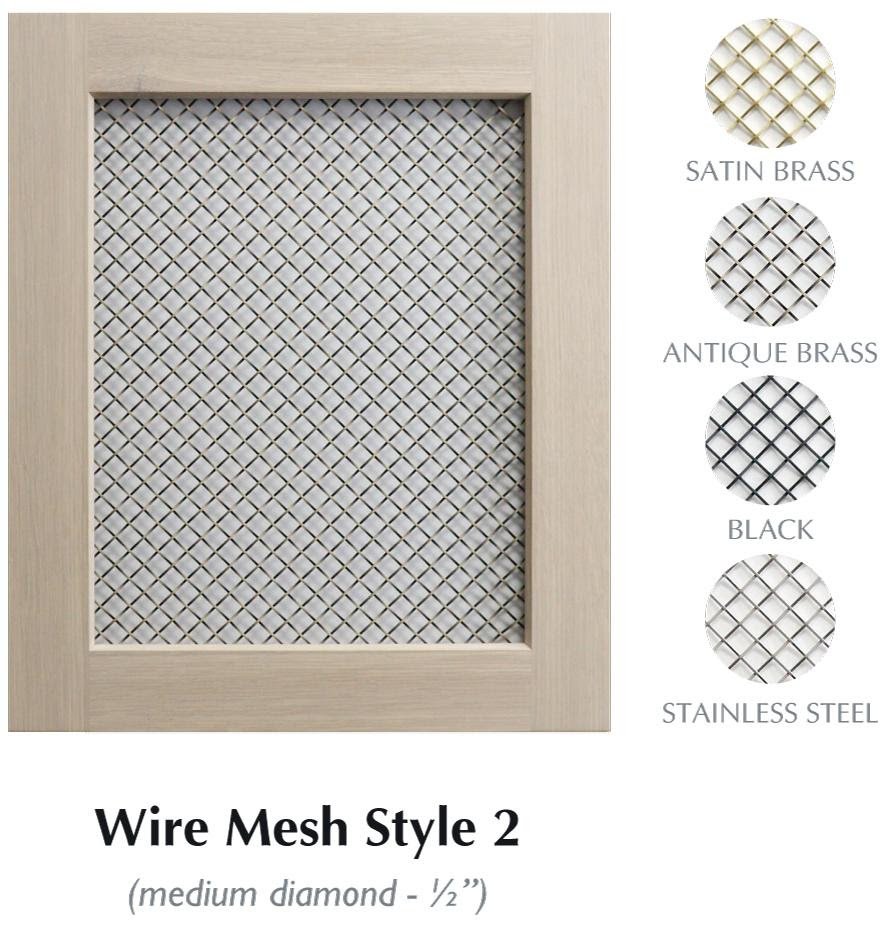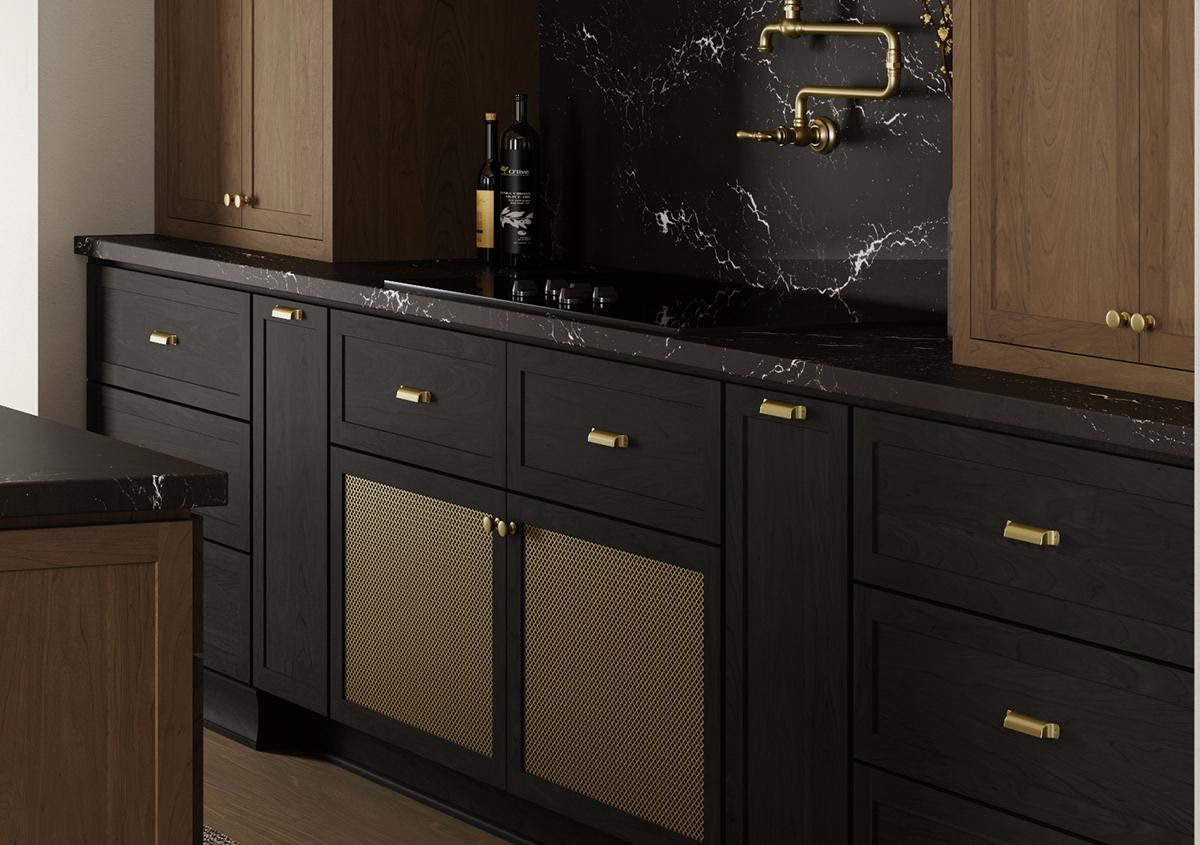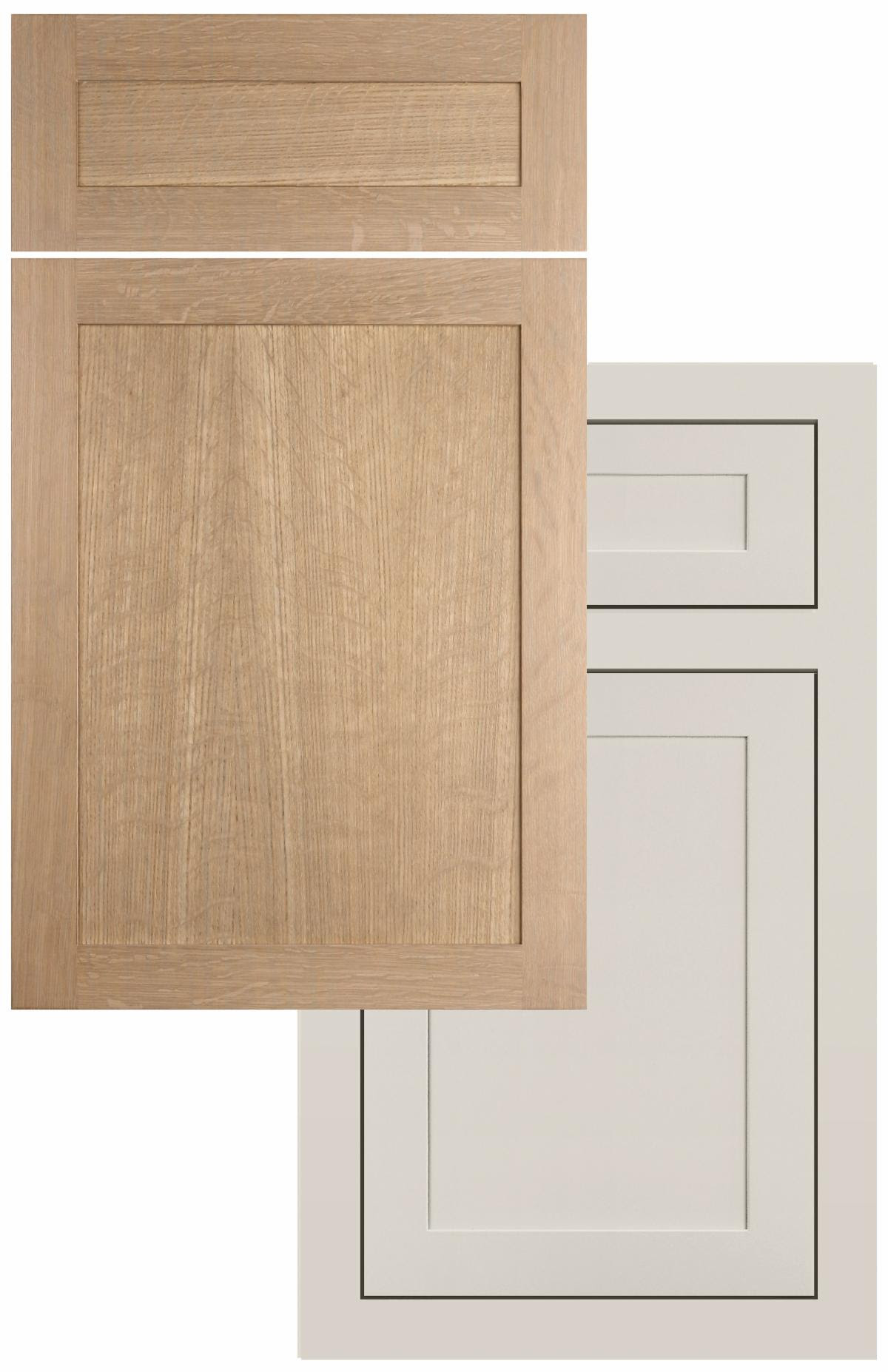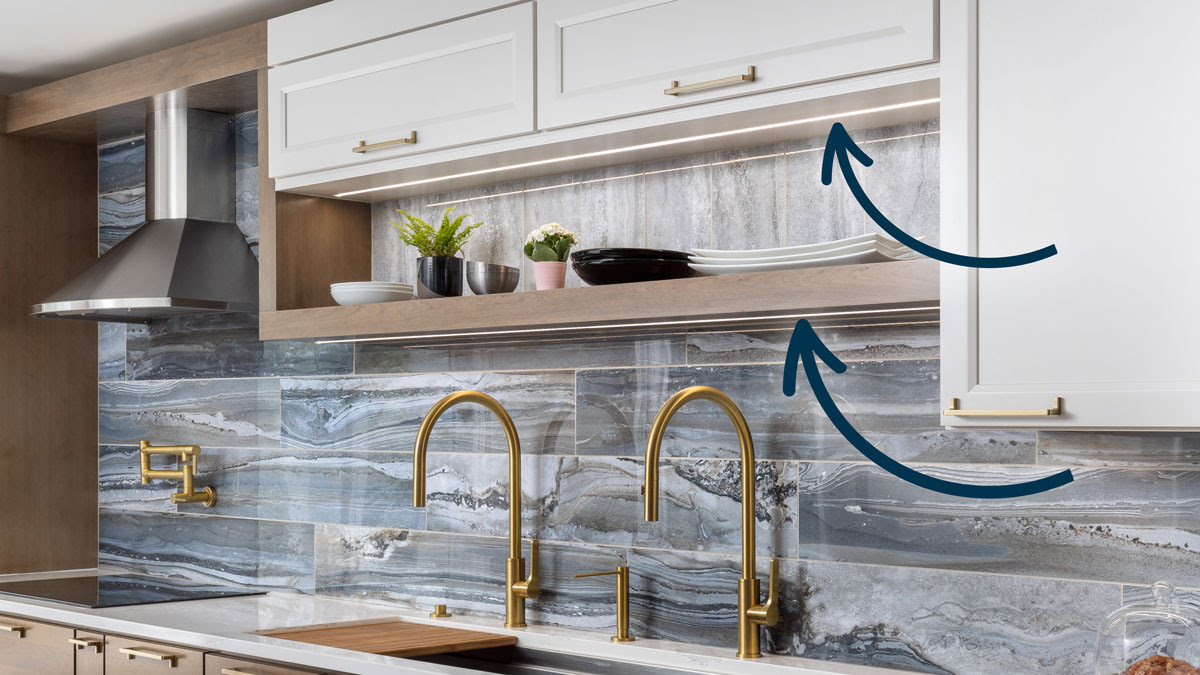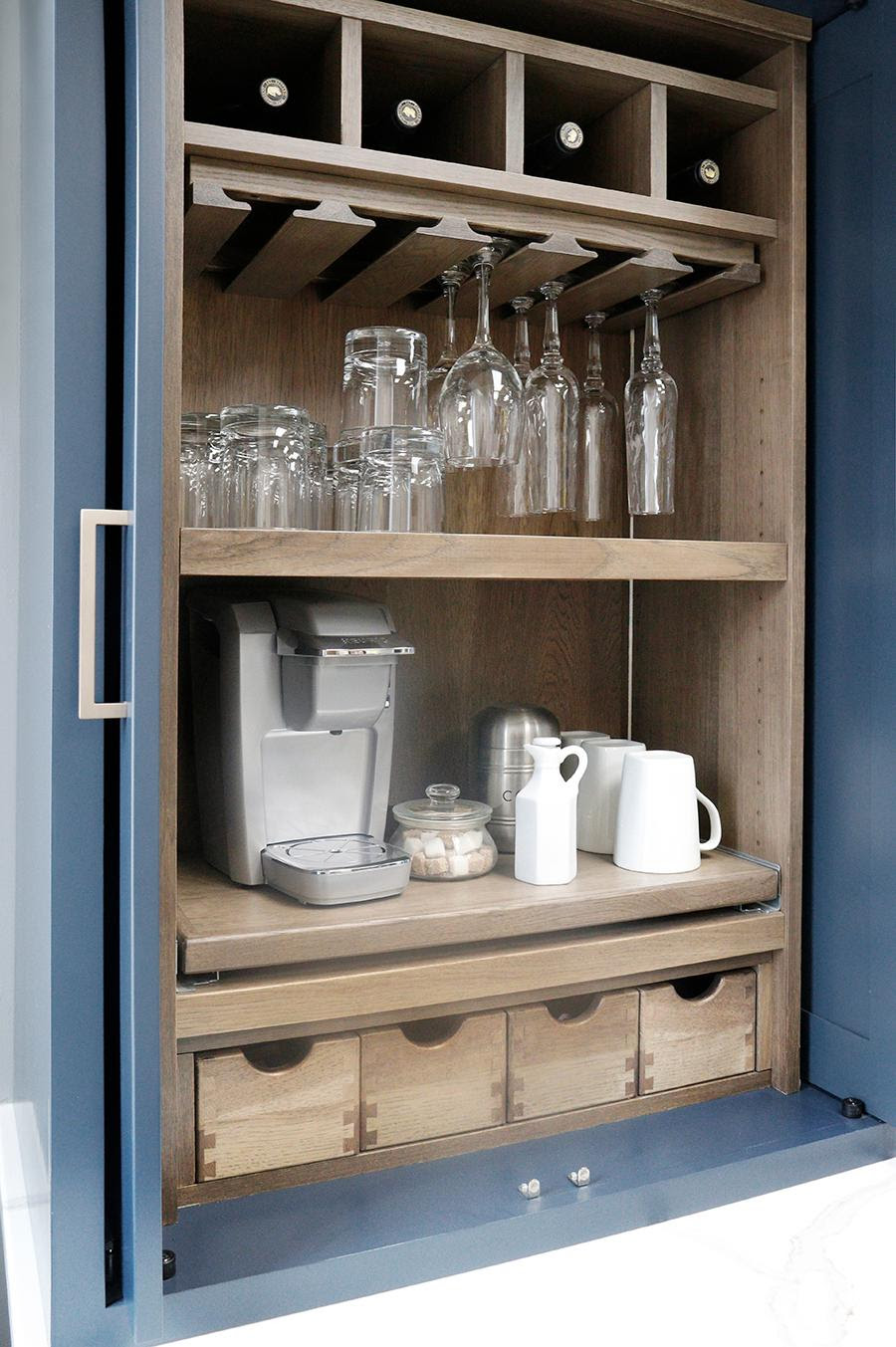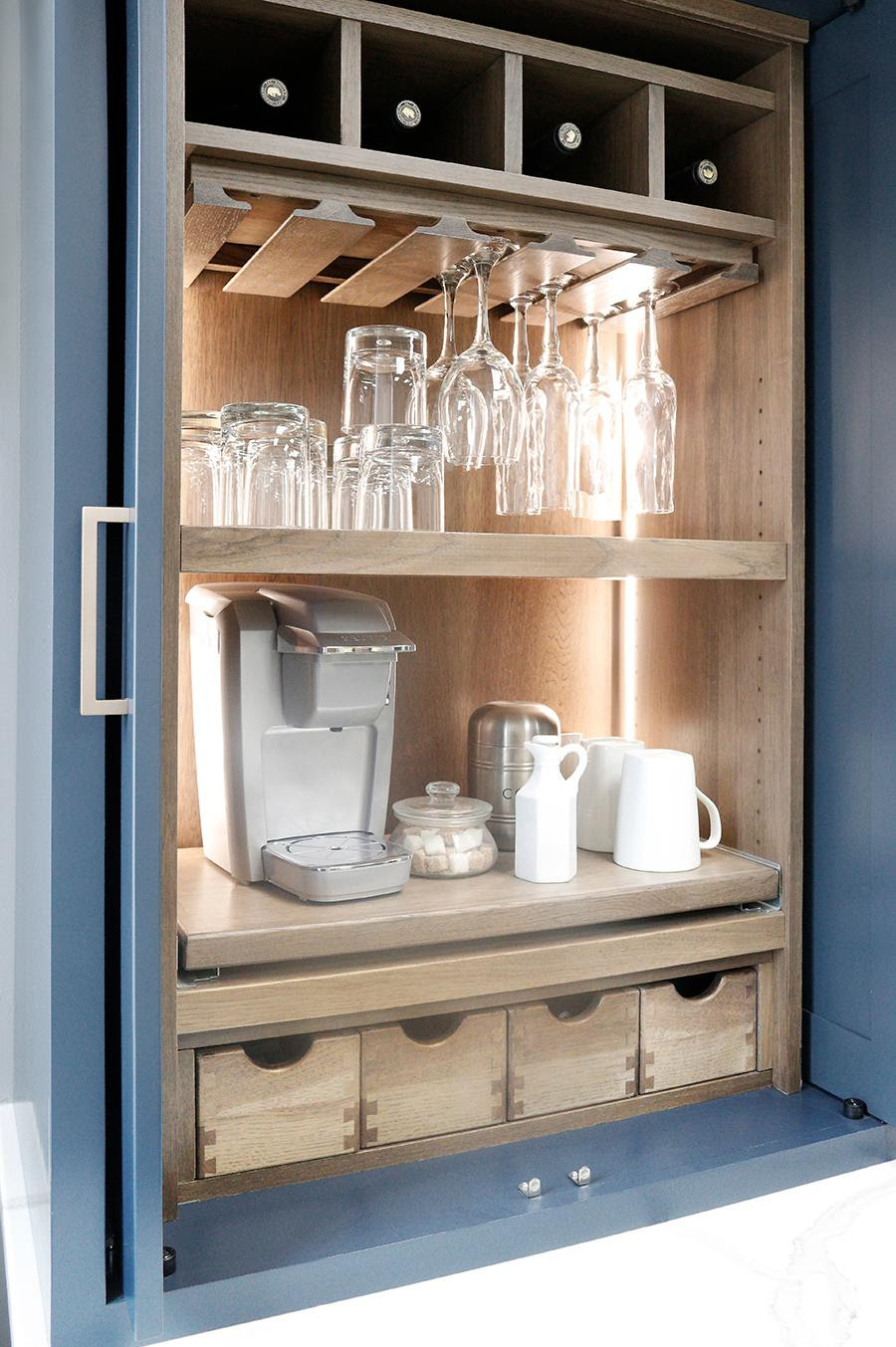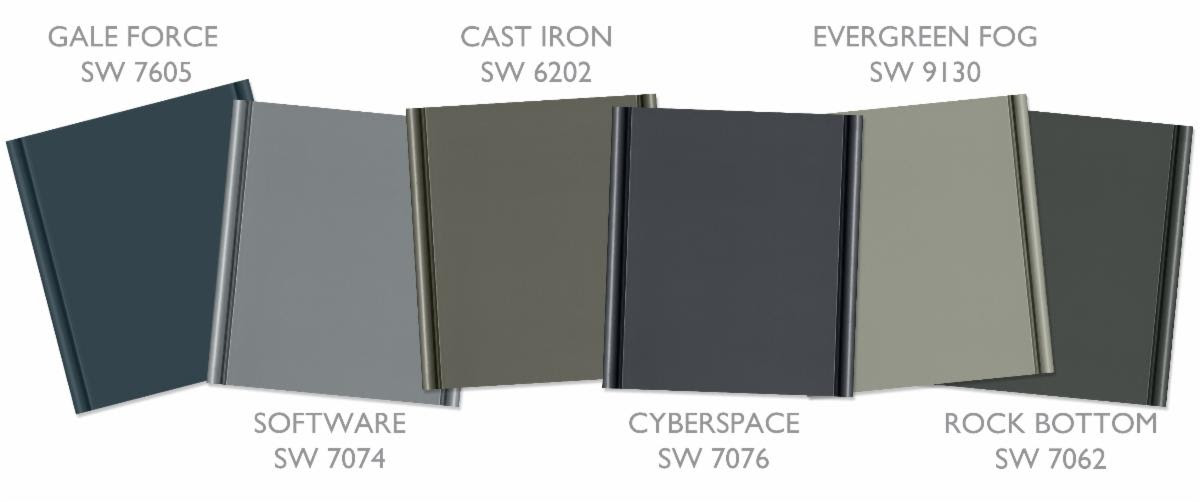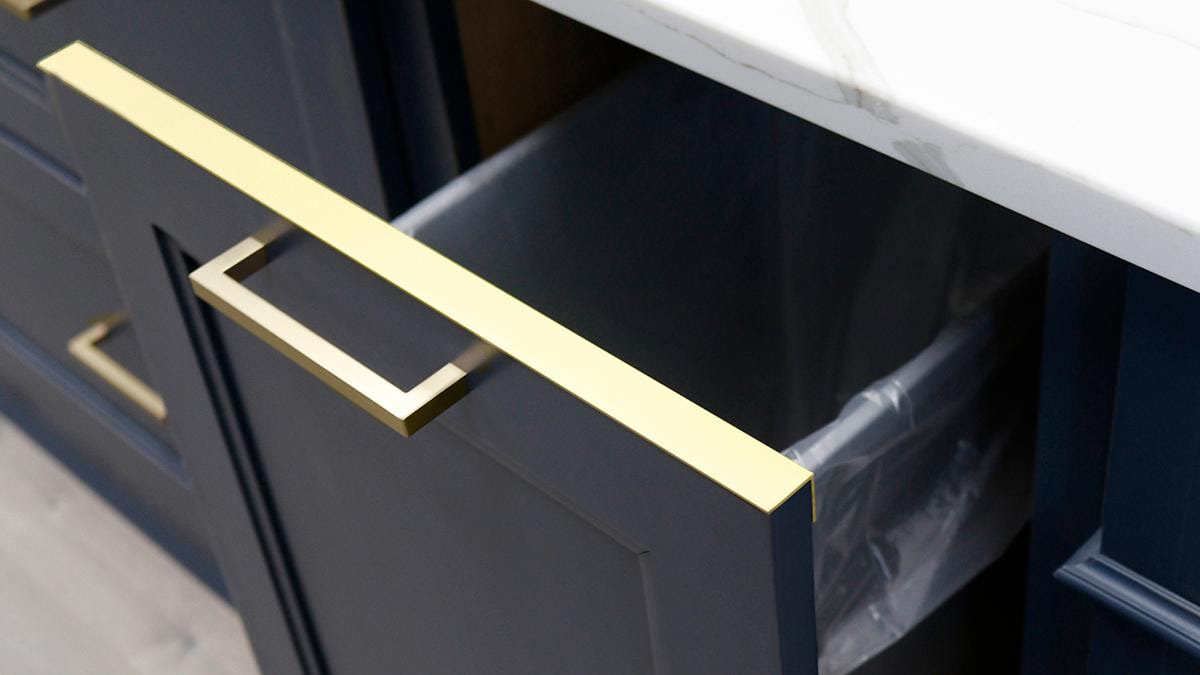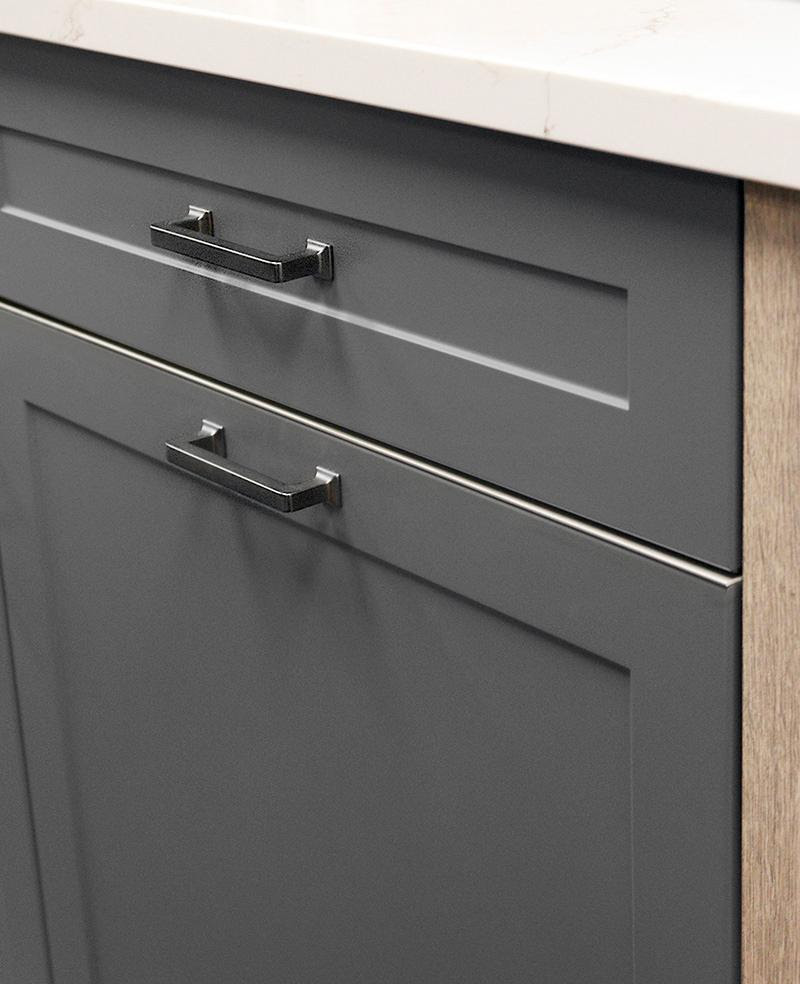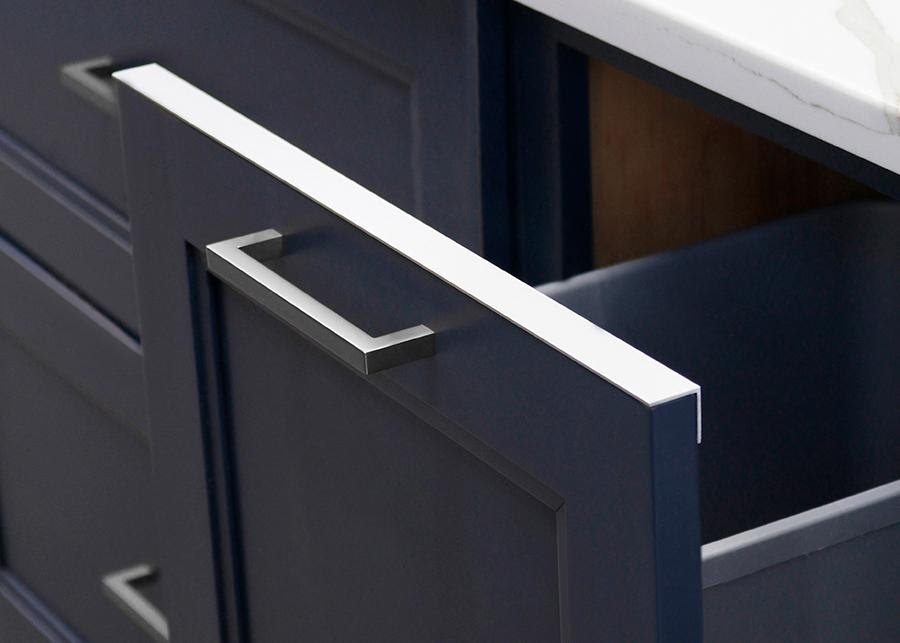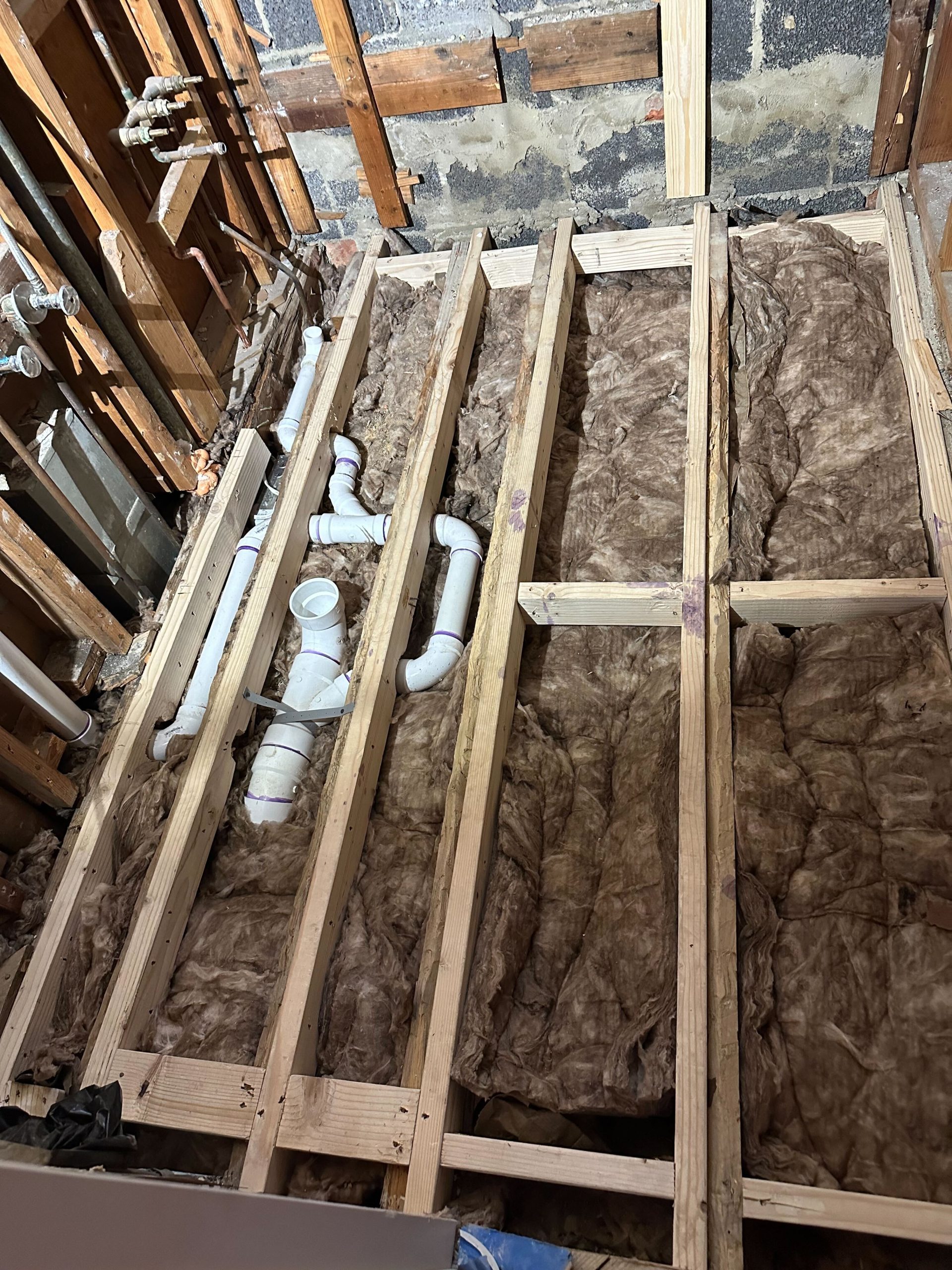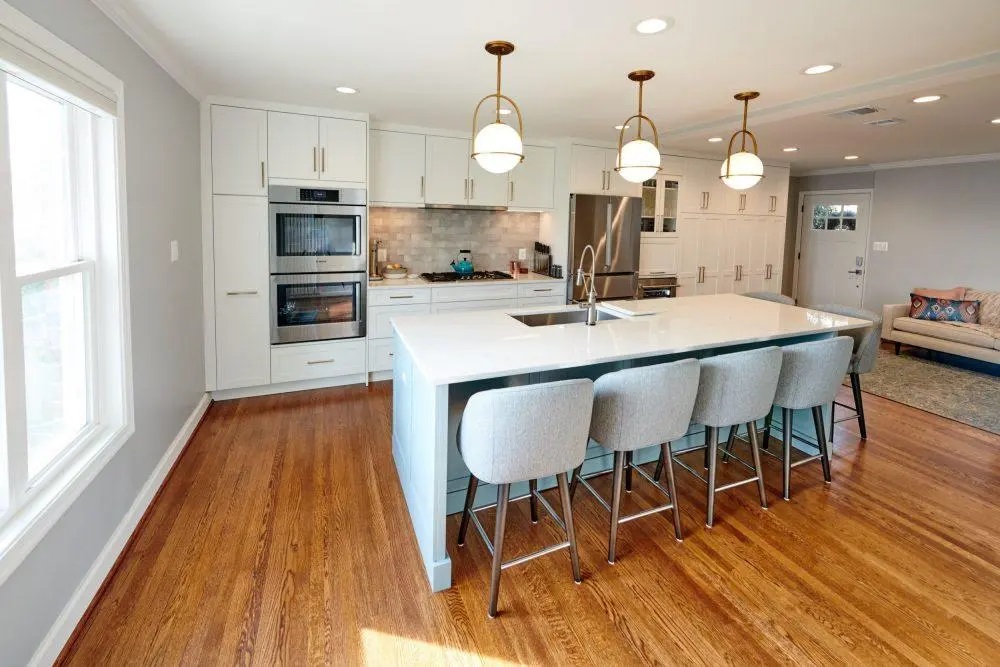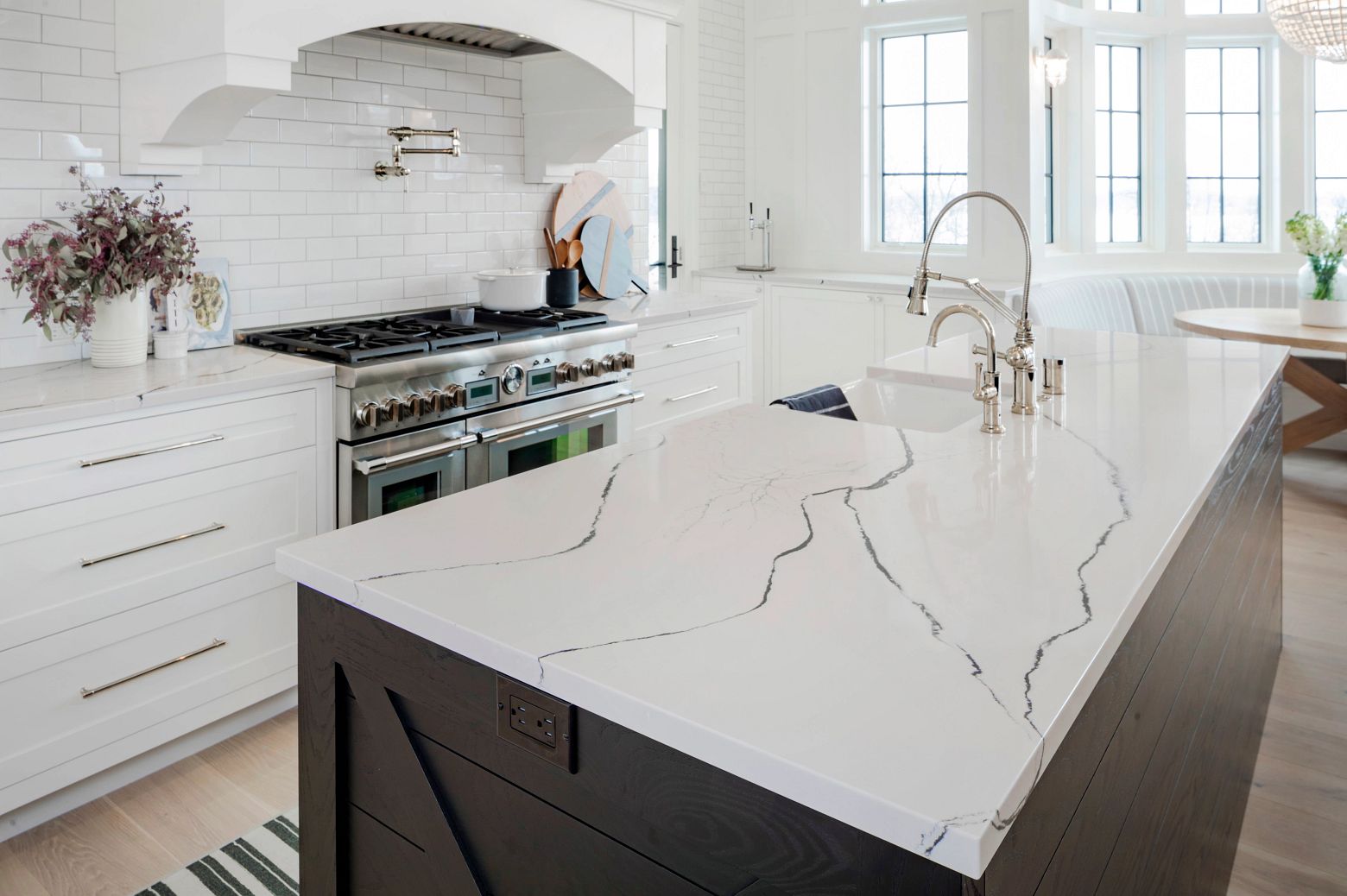Navigating Change Orders and Unforeseen Conditions in Home Renovation
Home renovation projects are thrilling ventures, promising a transformed living space that meets your dreams and needs. However, they often come with their own set of challenges, particularly when it comes to change orders and unforeseen conditions. Let’s dive into the intricacies of handling these unexpected situations, guided by real-life examples from our recent projects.
The Unpredictable Nature of Renovations
In every renovation, we aim for smooth sailing, but the reality is that homes, especially older ones, can harbor surprises. These unforeseen issues often remain hidden until work begins, making them impossible to predict during initial assessments.
Case Study 1: The Ceiling Dilemma
Take, for example, a recent project where we were tasked with remodeling a ceiling. Only during the demolition phase did we discover the ceiling was significantly out of plumb. This issue was undetectable during the initial inspection and only came to light after we began the work. To address this, we offered the homeowner two options:
- Level the ceiling for $3,750 ensuring a structurally sound and aesthetically pleasing finish.
- Install a taller starter molding for $1,577 which would conceal the ducting and provide a clean look without extensive structural work.
Case Study 2: The Bathroom Flooring Challenge
Similarly, during a master bathroom renovation, we encountered a major hurdle with the existing flooring. The concrete subfloor, attached to the original floor, needed complete removal. This additional task included demolishing the existing subfloor, sistering the joists, and installing a new subfloor, leading to an extra cost of $945.
Managing Change Orders
Change orders, a necessary evil in renovations, arise from these unforeseen conditions. They are not just additional costs but crucial steps to ensure the longevity and quality of the work. Communication is key in these situations. We ensure our clients are fully informed about the issue, the proposed solutions, and the associated costs. This transparency builds trust and understanding.
Conclusion: Embracing Flexibility and Transparency
In conclusion, while change orders and unforeseen conditions are not ideal, they are an integral part of the renovation journey. Our commitment to transparency, quality, and client satisfaction helps navigate these challenges effectively. We believe in turning these obstacles into opportunities for betterment, ensuring each project’s success, even in the face of the unexpected.
Thank you for reading,
Eric
Elevate Your Kitchen: Discover the Ideal Sink from BLANCO, Allora, and Kohler
Welcome to the realm where functionality meets elegance in kitchen design. Here, we explore the distinct qualities of BLANCO, Allora, and Kohler sinks, each offering unique advantages for your kitchen.
BLANCO DIAMOND Super Single - A Synthesis of Durability and Style
The BLANCO DIAMOND Super Single Sink, crafted from SILGRANIT, combines strength with a sophisticated look. Resistant to heat, scratches, and impact, this sink is perfect for busy kitchens. Discover more about BLANCO DIAMOND Super Single.
Allora Undermount Sinks - Customizable Elegance
Allora sinks offer a range of sizes, corner styles, and the option of a double bowl, fitting various kitchen styles and needs. Explore Allora Undermount Sinks.
Kohler Whitehaven - The Quintessence of Farmhouse Chic
Kohler’s Whitehaven sink, with its large basin and enameled cast iron construction, offers durability and a timeless farmhouse look. Its Self-Trimming® design makes installation effortless. Learn about Kohler Whitehaven.
NEKA Custom Stone Sinks - Seamlessly Sophisticated
NEKA elevates kitchens with custom stone sinks made from countertop materials, ensuring a seamless and luxurious finish. NEKA is renowned for its quality craftsmanship and innovative stone finishes.
Below is the updated list of in stock sinks. The minimum cabinet size and dimensions for each sink are noted. If you’d like to do a sink not in this list, we can certainly do that for you.
BLANCO Single Bowl Kitchen Undermount Sinks:
Minimum cabinet width for these Blanco sinks is 36” sink dimensions are 36” x 18”.
Stainless Steel Kitchen Undermount Sinks:
- KSN-3018-9-S: Min. Cab. 33″ | 30″x18″
- KSN-3118-9-D: Min. Cab. 33″ | 31″x18″
- KSN-2318-9-S: Min. Cab. 24″ | 23″x18″
- KSN-2321-9-S: Min. Cab. 24″ | 23″x21″
- KH-3318-10-S-R15: Min. Cab. 36″ | 33″x18″
- KH-3018-10-S-R15: Min. Cab. 33″ | 30″x18″
- KH-2718-10-S-R15: Min. Cab. 30″ | 27″x18″
- KH-2318-10-S-R15: Min. Cab. 24″ | 23″x18″
Wet Bar & Laundry Undermount Sinks:
- KH-1717-10-S-R15: Min. Cab. 21″ | 17″x17″
- KSN-2016-9-S: Min. Cab. 21″ | 20″x16″
- KSN-1616-8-S: Min. Cab. 33″ | 16″x16″
Bathroom Undermount Sinks:
- CMI 561-0409: Min. Cab. Size Not Specified | 17″x14″
- CMI 561-8826: Min. Cab. Size Not Specified | 17″x13″
Farmer Sinks:
- K-6489-0: Min. Cab. 37″ | 35″x21″ (Kohler’s Whitehaven is also available in various heights, styles in finishes)
- K-5415-NA: Min. Cab. Size Not Specified | 35.5″x21 1/4″
For the custom stone sink, the dimensions are provided, but not the model number or minimum cabinet size:
- Custom Stone Sink: Dimensions Specified | Min. Cab. Size Not Specified
What it Takes to Become a Certified Kitchen and Bath Designer (CKBD)
While looking for a kitchen designer or full-service remodel firm, you may have come across designations such as ‘CKBD’ or ‘AKBD’. Wondering what these certifications are and if they’re important for your kitchen remodel? We’ll break it down for you!
At Bath+Kitchen, our clients love working with our designers for a myriad of reasons, including their passion, professionalism, knowledge, quality of work, and attention to detail.
Each member brings a wealth of experience and unique strengths to our team. As a premier kitchen and bath design, remodeling, and custom cabinetry specialist in Virginia, Maryland, and Washington, DC, we pride ourselves on providing exceptional service and expertise to our clients.
See: Our service areas
But what drives us together is working to meet high industry standards, in line with our NKBA certifications.
At Bath+Kitchen, our design team is led by NKBA-certified designer Kat Reynolds. In this blog, we will discuss the benefits of working with Certified Kitchen and Bath Designers (CKBD) to bring your kitchen to life.
Need inspiration for your new kitchen? Explore our portfolio.
The CKBD certification represents a high level of professionalism and proficiency in the industry, ensuring that your project is in the best hands. From understanding the latest trends and materials to crafting functional and beautiful spaces, a CKBD designer can make your remodeling experience smooth, efficient, and enjoyable.
In this blog post, we will explore what it takes to become a CKBD. We will discuss the rigorous process, the qualifications required, and the benefits of working with a CKBD-certified professional. Whether you’re a homeowner looking to hire a designer or an aspiring designer seeking a prestigious certification, this post will provide valuable insights into the world of kitchen design excellence.
Let’s dive in and discover what it takes to achieve the coveted CKBD certification!
What is a CKBD-certified designer?
A Certified Kitchen and Bath Designer (CKBD) is a professional who has demonstrated exceptional expertise and skills in designing kitchens and bathrooms.
This prestigious certification, awarded by the National Kitchen & Bath Association (NKBA), requires designers to meet rigorous educational and experience requirements, as well as pass a two-part comprehensive exam. To qualify, a candidate must be an NKBA member in good standing.
CKBD-certified designers are trained in the latest industry trends, materials, and technologies, ensuring that they can create beautiful, functional, efficient, and fully-customized spaces for their clients. By choosing a CKBD-certified designer, you can trust that your kitchen and bath projects will be handled with the utmost professionalism and care.
Another valuable certification awarded by NKBA is the Associate Kitchen and Bath Designer (AKBD) certification. This credential recognizes professionals who have a foundational understanding of kitchen and bath design principles and industry standards.
To obtain the AKBD certification, designers must complete a series of educational courses and pass a comprehensive exam. Clients can trust that an AKBD-certified designer possesses a strong knowledge base and is dedicated to delivering quality work.
Qualifying for a CKBD certification
A CKBD is a highly skilled professional who has met the rigorous qualifications set forth by the NKBA to ensure expertise in kitchen and bath design.
The CKBD certification represents a designer’s commitment to excellence and dedication to staying up-to-date with industry trends and best practices. To become a certified kitchen designer, candidates must meet the following qualifications:
1. NKBA membership: Candidates are required to be NKBA members in good standing.
2. Education: Aspiring certified kitchen designers can come from a range of educational backgrounds, which will determine how much experience or NKBA-approved education (see chart below) they will need in order to qualify. The NKBA lists these four CKBD candidate categories:
- Allied Professional: NCIDQ Certificate Holder or Registered Architect
- Post-Secondary Education: Master’s, Bachelor’s or Associate’s Degree or Diploma in Interior Design or Architecture.
- Post-Secondary Education: Certificate in Interior Design or Architecture.
- Alternative Pathway: No degree, diploma or certificate in Interior Design or Architecture.
This education requirement ensures that designers have a solid foundation in kitchen and bath design principles, materials, and technologies.
3. Experience: CKBD candidates must meet a certain number of years of full-time kitchen and bath design experience. The number will depend on their education requirements. At least two of those years should be dedicated to full-time design work, showcasing their ability to handle various projects and clients.
4. Exam: To obtain the CKBD certification, candidates must pass a two-part comprehensive exam that tests their knowledge of design, planning, construction, and project management. Part one is multiple choice, and part two is a kitchen and drawing. This exam ensures that certified kitchen designers possess the skills and expertise required to design high-quality, customized spaces in line with current best practices.
By meeting these qualifications, certified kitchen designers demonstrate their commitment to providing exceptional service and delivering high-quality work. Clients can trust that their kitchen and bath projects will be in the hands of a knowledgeable and experienced professional, ensuring a smooth and successful remodeling experience.
Maintaining a CKBD certification
Maintaining a CKBD certification requires ongoing professional development to ensure designers stay current with industry trends, technologies, and best practices. The NKBA mandates that CKBD-certified professionals complete a minimum of 20 hours of continuing education units (CEUs) every two years.
These CEUs can be earned through NKBA-approved courses, workshops, seminars, or other industry-related events. By fulfilling this requirement, certified kitchen designers demonstrate their commitment to staying updated in the field, ensuring they continue to provide clients with exceptional service and cutting-edge designs.
Why is it important for kitchen designers to be certified?
We believe, to create beautiful, functional, and efficient spaces tailored to the unique needs and preferences of each client, kitchen designers must have a commitment to excellence and up-to-date knowledge of trends, technology, techniques, and more.
Obtaining a certification, such as the CKBD, is a significant way for designers to showcase that commitment to excellence, professionalism, and industry standards. There are several reasons why it is important for kitchen designers to be certified:
1. Expertise: A certified kitchen designer has undergone rigorous training and education, ensuring they possess a comprehensive understanding of design principles, materials, technologies, and industry trends. This expertise allows them to create custom kitchen designs that are not only visually appealing but also highly functional, maximizing the use of space and ensuring the kitchen meets the specific needs of the client.
2. Experience: To become certified, kitchen designers meet a stipulated number of years of solid experience. This experience requirement ensures that certified designers have handled a wide variety of projects and clients, honing their skills and knowledge in real-world settings.
3. Professionalism: The certification process, including the comprehensive exam, demonstrates a designer’s commitment to professionalism and adherence to industry standards. Clients can trust that a certified kitchen designer will handle their project with the utmost care and attention to detail, ensuring a smooth and successful remodeling experience.
4. Continuing education: Certified kitchen designers are required to complete ongoing professional development to maintain their certification. This commitment to continuing education ensures that they stay current with industry trends, technologies, and best practices, enabling them to provide clients with cutting-edge designs and the latest innovations in kitchen design.
5. Client confidence: Hiring a certified kitchen designer provides clients with a sense of confidence and trust, knowing that their project is in the hands of a knowledgeable and experienced professional. This trust can lead to better communication, smoother project execution, and ultimately, a higher level of satisfaction with the finished product.
6. Networking and resources: Certified kitchen designers have access to a network of industry professionals and resources through organizations like the NKBA. This network can be invaluable for staying informed about the latest trends, products, and technologies, as well as for connecting with other professionals for collaboration or referrals.
7. Ethical practices: Certified kitchen designers are bound by a code of ethics and professional conduct, ensuring they adhere to the highest standards of integrity and professionalism. This commitment to ethical practices provides clients with peace of mind, knowing that their project will be handled with honesty and transparency.
While many uncertified professionals may be highly-competent, a certified kitchen designer typically provides clients with a higher level of service, ensuring that their kitchen remodeling project is executed seamlessly and exceeds expectations.
Risks of hiring a contractor or remodel firm without certified designers on board
Hiring a contractor or remodeling firm without certified kitchen designers on their team can pose significant risks to the success of your kitchen renovation project.
Without certified professionals, the team may lack the necessary expertise and experience in kitchen design, leading to subpar results and potential issues with functionality, aesthetics, or building code compliance. Uncertified designers may also be unfamiliar with current design trends, materials, and technologies, resulting in outdated or inefficient designs.
Ultimately, working with a team that lacks certified kitchen designers can lead to miscommunication, delays, and dissatisfaction with the final outcome. That’s why we recommend choosing a firm with certified professionals.
In addition to certifications, look for a solid design portfolio
It is crucial to consider the designer’s portfolio when choosing the right professional for your kitchen remodeling project. A great portfolio showcases the designer’s creativity, skillset, and experience, offering valuable insight into their design style and ability to execute various projects successfully.
BPK project story: Turning Kristen & Tim’s 1960 kitchen into a 2021 dream
Here are some reasons why a great portfolio is essential when selecting a kitchen designer:
1. Design style: A designer’s portfolio highlights their design style, allowing you to determine if their aesthetic aligns with your personal preferences and vision for your kitchen. It should present you with a variety of styles and projects that demonstrate the designer’s versatility and ability to adapt to different client needs.
2. Creativity: A well-rounded portfolio displays the designer’s creativity and ability to think outside the box. This is particularly important for clients who want a unique, personalized kitchen design that sets their space apart from standard, cookie-cutter kitchens.
3. Problem solving: It also demonstrates the designer’s ability to solve problems and overcome challenges in various projects. Look for examples of how the designer has effectively addressed unique spatial constraints, incorporated innovative storage solutions, or met specific client requirements.
4. Quality of work: It provides a visual representation of the designer’s work quality, including attention to detail, craftsmanship, and overall project execution. High-quality images and detailed descriptions of each project can help you gauge the designer’s commitment to delivering exceptional results.
5. Client testimonials: Many designers include client testimonials in their portfolio, offering valuable insight into their professionalism, communication skills, and ability to meet or exceed client expectations. These testimonials can help you understand the designer’s work ethic and dedication to client satisfaction.
5 red flags when hiring a kitchen designer
When hiring a kitchen designer, watch out for these five red flags that may indicate potential issues:
1. Lack of certification: A designer without a recognized certification, such as CKBD, may lack the necessary expertise, experience, and commitment to industry standards.
2. Poor communication: Difficulty in reaching the designer, slow response times, or unclear explanations may indicate potential communication issues during the project.
3. Limited portfolio: A limited or unimpressive portfolio may signal a lack of experience, versatility, or creativity in kitchen design.
4. Negative reviews: Multiple negative client reviews or testimonials can raise concerns about the designer’s professionalism, work quality, or ability to meet client expectations.
5. High-pressure sales tactics: Aggressive sales tactics or pressure to make quick decisions may indicate that the designer prioritizes their interests over your project’s success.
Make your kitchen remodel smoother with NKBA-certified designers
Choosing an NKBA-certified kitchen designer for your remodeling project ensures a seamless experience from start to finish. At Bath+Kitchen, our certified professionals possess the expertise, creativity, and commitment to excellence necessary to transform your space into a functional and beautiful kitchen.
With our efficient design process, timely material procurement, and high-quality construction, you can trust that your project is in capable hands! Start here.
Key References:
- NKBA, Certification
https://nkba.org/certification/
- Read This Before Hiring a Kitchen Designer
https://www.thisoldhouse.com/kitchens/21015837/read-this-before-hiring-a-kitchen-designer
Kitchen Design Trends To Look For in 2023

It’s no secret that the kitchen plays a large role in the appearance and feel of the home. It’s important that it’s a space that you are pleased with and enjoy being in. As we look ahead to a new year, it’s time to consider what the kitchen trends will look like in 2023. According to experts, you can expect to see bold colors, mixed materials, and more multifunctional spaces. Continue reading to learn more about what we’ll be seeing in the kitchen in 2023.
Bold Cabinetry
As we move closer to a new year, cabinetry will be one of the bigger focuses in kitchens. Expect to see more bold cabinet color choices, mixed with other interesting and unique finishes. It’s also anticipated that we’ll be seeing more two-toned cabinetry, as having contrasting colors can create depth and elevate the overall look of your kitchen by bringing in subtle variations. In addition to the contrasting, closed cabinetry is out and open shelf like cabinetry is in. Rather than having closed upper cabinets above your countertops, there is going to be a shift toward a more open concept when it comes to cabinets, allowing for a more organic feel. Similar to the open concept design for cabinets, it’s also expected to see a revival of the stained-glass cabinet look. While the glass cabinet look has been around for years, stained-glass has come and gone. It looks like 2023 is the year when we see the return of that. The stained-glass design plays off of the open concept of typical glass cabinets, while also adding in some extra details. Creative cabinetry will be making its presence known in 2023 and for those who are looking to make changes to their kitchen, replacing your cabinets can be a great way to freshen up your kitchen without a full renovation. When redoing your cabinets, it’s up to you what you want to do and at Bath+Kitchen Remodel, it’s our job to help bring your vision to life with our custom and semi-custom options. It’s important that you love your kitchen, and it’s a place that you enjoy being in.
Creative Backsplashes
While changing the backsplash in your kitchen is no easy task, it’ll be worth it in the long run. It’s important to figure out which type of backsplash you want, as it can get expensive quickly. When looking to the experts for what they are looking forward to seeing in 2023, they said that dramatic stone is one of many trends that will be making its presence known this upcoming year. Using stone backsplash allows you the ability to choose from a busy stone or a solid stone backsplash to help best compliment your existing cabinets. If you aren’t on board with stone backsplash, another trend that is anticipated is detailed backsplash. Types of detailed backsplashes that we might be seeing are mixed materials; having a solid color backsplash that will stand out against more subtle cabinetry or countertops, sustainable backsplashes such as ceramic tiles glazed with pigments derived from industrial metal waste or even reclaimed wood tile. Another type of backsplash that may grow in popularity this upcoming year is using the same material for your backsplash as your countertops. Using the same material for both can give your kitchen more depth, giving it a sleek, elevated appearance.
Diversified Materials
Rather than using the same material in your kitchen for your island and countertops, there will be a shift toward mixing materials, such as using wood, stone, metals, and ceramics that will go alongside new and upcoming mediums. This result will be visually and textually pleasing, as it’ll create a nice contrast between the materials, allowing parts of the kitchen to stand out more than others. In addition to mixing materials for countertops, the muted tone and style will be making its way out, creating room for more dramatic styles of marble and other countertop materials. The rise in popularity of using metal as countertops comes from the overall minimalist and modern appearance they have, as well as being antibacterial, and easy to clean and maintain. The diversity of materials for countertops will also be making its way to the overall layout in the kitchen. Adding more color and contrast into the kitchen will become more popular in the new year as the desire for more dramatic designs are implemented. Taking the time to plan out your kitchen renovation will allow the process to go more smoothly because you won’t have to stress about figuring out what you want along the way, as it’ll all be completed before the renovation process begins. Along with planning out what you would like to upgrade in your kitchen, making sure you order anything you may need ahead of time will help prevent any delays or added stress.
Consider Budget
Renovating your kitchen can be costly. It’s important to figure out what you’d like to have redone in your kitchen and determine what your budget will be for the renovation. Creating a budget for your renovation will ensure that you know what you can afford and how much you’re willing to spend. While budgeting is essential to avoid overspending, how you’re financing this project is just as important, if not more. While planning your renovation, look into available financing options to determine what works best for you and your wallet. If you’re planning a full kitchen remodel it’ll be expensive, so if you don’t have the funds available upfront and have lived in your home for at least 6 years, look into qualifying for a tax-deductible home equity loan. This is a great way to get financial assistance through the equity you’ve built up in your home while adding value to the home itself.
2023 is going to have new and exciting design opportunities as well as bringing in some styles from the past. It’ll be interesting to see where the trends of 2023 take kitchen designs and what will become the most popular trend in the new year. While you may not be updating your kitchen every year, seeing the trends that are being predicted for the new year can provide you with new design ideas and inspiration for when you choose to update your kitchen.
Arlington Kitchen Magic: Unleashing Your Inner Chef with Strategic Upgrades

Arlington homeowners, it’s time to embrace home cooking and ditch the takeout! By revamping your kitchen, you’ll not only add value to your Arlington, VA home but also enjoy numerous benefits such as customized ingredients, bonding with loved ones, learning new cooking techniques, reducing food waste, and saving money. Image source: Unsplash.com – Jason Briscoe
Embark on a culinary journey by addressing these common kitchen quandaries in your Arlington, VA home:
Transform your Arlington kitchen into a culinary oasis by maximizing space and functionality. Consider adding a kitchen island, fold-down countertop, window seat with storage, rolling cart, or wall-mounted table for increased storage and work area.
Cramped Quarters:
Transform your Arlington kitchen into a culinary oasis by maximizing space and functionality. Consider adding a kitchen island, fold-down countertop, window seat with storage, rolling cart, or wall-mounted table for increased storage and work area.
Stumbling Through Your Workspace:
Revitalize your kitchen’s flow by focusing on the “golden triangle” of stove, refrigerator, and sink. Rearrange cooking gear for maximum efficiency, reconfigure cabinets and countertops, and improve traffic flow. For a tailor-made solution, consider consulting a local Arlington kitchen designer or contractor.
Dim and Dreary:
Brighten your Arlington kitchen with proper lighting. Install under-cabinet lighting, upgrade fixtures, paint walls and cabinets in lighter shades, and add mirrors or reflective surfaces. Clean your windows and add task lighting for a well-lit workspace.
Ventilation Woes:
Combat mold, mildew, and lingering odors by improving your kitchen’s ventilation. Install a range hood, vented exhaust fan, window, or skylight, and upgrade windows and doors for energy efficiency.
Cleanup Conundrums:
Make cleaning a breeze with backsplashes, a pantry, easy-to-clean flooring, and low-maintenance countertops. Add a dishwasher and optimize ventilation for a sparkling kitchen.
Outdated Gadgets:
Upgrade your Arlington culinary arsenal with modern appliances that make cooking faster, more efficient, and enjoyable. Begin with small, impactful appliances, prioritize upgrades, choose energy-efficient options, and plan for maintenance.
By incorporating these creative solutions, your Arlington, VA kitchen will transform into a hub of culinary inspiration. You’ll not only enjoy a more functional space but also save money, reduce waste, and create a welcoming environment for family and friends. Say goodbye to takeout and hello to your inner chef, Arlington homeowners!
Quartz vs. Granite: Which Countertop Material Reigns Supreme?
Are you trying to decide between granite and quartz for your new kitchen countertop? Both materials have their advantages and disadvantages.
Granite is a natural stone, and each slab is unique. It’s heat-resistant and scratch-resistant, but requires regular sealing to avoid stains and bacteria buildup. On the other hand, quartz is highly durable, resistant to scratches, stains, and bacteria, and comes in various colors and patterns. It doesn’t need sealing like granite, but it’s usually more expensive. The choice ultimately depends on your personal preferences and needs.
If you’re considering granite, it’s essential to note that each slab is unique and should be selected in person to get the exact pattern and color that you want.
Here are three pros and cons of granite:
Pros:
- Unique and natural patterns: no two slabs are the same, making it an excellent choice for those who want a one-of-a-kind countertop.
- Heat-resistant: granite is a great choice for avid cooks who frequently use hot pots and pans.
- Scratch-resistant: granite is very hard and can withstand scratches from knives and other sharp kitchen tools.
Cons:
- Requires regular sealing: granite is porous and can stain easily if not properly sealed.
- Expensive: while granite can be a great investment, it can also be pricey, especially if you opt for a rarer or more unique slab.
- Heavy: granite is a dense and heavy material, which can make installation more difficult and expensive.
As for quartz, here are three pros and cons:
Pros:
- Durable: quartz is very hard and can withstand the wear and tear of daily use, making it a great choice for busy kitchens.
- Low maintenance: unlike granite, quartz doesn’t require regular sealing to prevent stains or bacteria buildup.
- Wide range of colors and patterns: quartz is available in a range of colors and patterns, making it easy to find a style that complements your kitchen.
Cons:
- Expensive: as mentioned earlier, quartz is typically more expensive than granite, which can make it a less desirable option for those on a tight budget.
- Can be prone to discoloration: while quartz is generally resistant to stains, it can discolor over time if exposed to direct sunlight or extreme heat.
Not heat-resistant: while quartz is resistant to scratches, it can be damaged by high heat, so it’s important to use trivets or hot pads to protect your countertop.

Top-notch Quartz Countertop Brands: Elevate Your Kitchen with These Stunning Options
Silestone’s new Ethereal Collection is a game-changer in the world of countertops, thanks to its innovative hybridQ+ technology. This breakthrough technology not only enhances the beauty of marbled colors but also takes sustainability and durability to a whole new level. The collection offers a range of unique and stunning designs that will elevate the look of any kitchen or bathroom. With its remarkable durability, Silestone’s Ethereal Collection is an excellent choice for high-traffic areas in the home, and its sustainability features make it an eco-friendly option. Plus, the collection’s innovative HybriQ+ technology ensures that your countertops will remain in pristine condition for years to come. If you’re looking for a beautiful and sustainable countertop option that incorporates cutting-edge technology, the Ethereal Collection by Silestone is definitely worth considering.
Silestone
Looking for a quartz countertop that gives you the luxurious feel of marble? Then look no further than Silestone, where you’ll find the most stunning and diverse options to choose from! Silestone is a popular brand of quartz countertops that is known for its durability, low maintenance, and beautiful design options. Silestone countertops are made up of over 94% natural quartz, making them extremely hard and resilient against scratches, stains, and impact. They are also non-porous, which means they do not require regular sealing like natural stone countertops such as granite. Silestone offers a wide range of colors and patterns and price points. Additionally, Silestone countertops are easy to clean and maintain, making them a great choice for busy kitchens and households.
Cambria
Cambria countertops are a popular choice for those looking for a high-quality quartz countertop. Cambria is a family-owned company that operates out of Minnesota and prides itself on producing a product that is 93% pure, natural quartz. Their countertops are made with proprietary technology that produces a non-porous, scratch and stain-resistant surface that requires no sealing or special maintenance. Cambria offers over 200 designs in various finishes, colors, and patterns, allowing customers to choose a unique look that fits their style. Their countertops are also backed by a lifetime warranty, ensuring that customers can have peace of mind knowing their investment is protected. Cambria’s commitment to quality and innovation has made them a leader in the quartz countertop industry.
Caesarstone
Caesarstone is a well-known brand of quartz countertops that offers a wide range of colors, patterns, and textures. Caesarstone countertops are made of 93% natural quartz, combined with a small amount of resin and pigments. This makes them highly durable, scratch-resistant, and low-maintenance. Caesarstone countertops are also non-porous, which means they don’t require sealing and are highly resistant to stains and bacteria buildup. They are easy to clean with soap and water and are an ideal choice for busy kitchens. Caesarstone offers a variety of collections, including the Classic, Supernatural, and Metropolitan collections, each with their unique color and pattern options. Whether you prefer a traditional or contemporary look, Caesarstone has a countertop option that will fit your style and needs.
MSI
MSI, or MSI Surfaces, is a leading supplier of countertops and other surfacing products for both residential and commercial applications. They offer a wide range of materials, including natural stone like granite and marble, as well as engineered quartz, porcelain, and other surfaces. MSI is known for their innovative designs and high-quality products, and their countertops come in a variety of colors, patterns, and finishes to suit any style or taste. In addition to their impressive product offerings, MSI also offers exceptional customer service and support, making them a top choice for homeowners and professionals alike.
Ultimately, the choice between granite and quartz comes down to your personal preferences and needs. Whether you choose granite for its natural beauty and unique patterns or quartz for its durability and low maintenance, make sure to select a material that complements your kitchen style and fits within your budget. And if you decide to go with quartz, consider brands like Cambria Quartz, Caesarstone, MSI Surfaces, or Silestone, especially with Silestone’s new Ethereal collection.
Silestone vs. Cambria Quartz Countertops
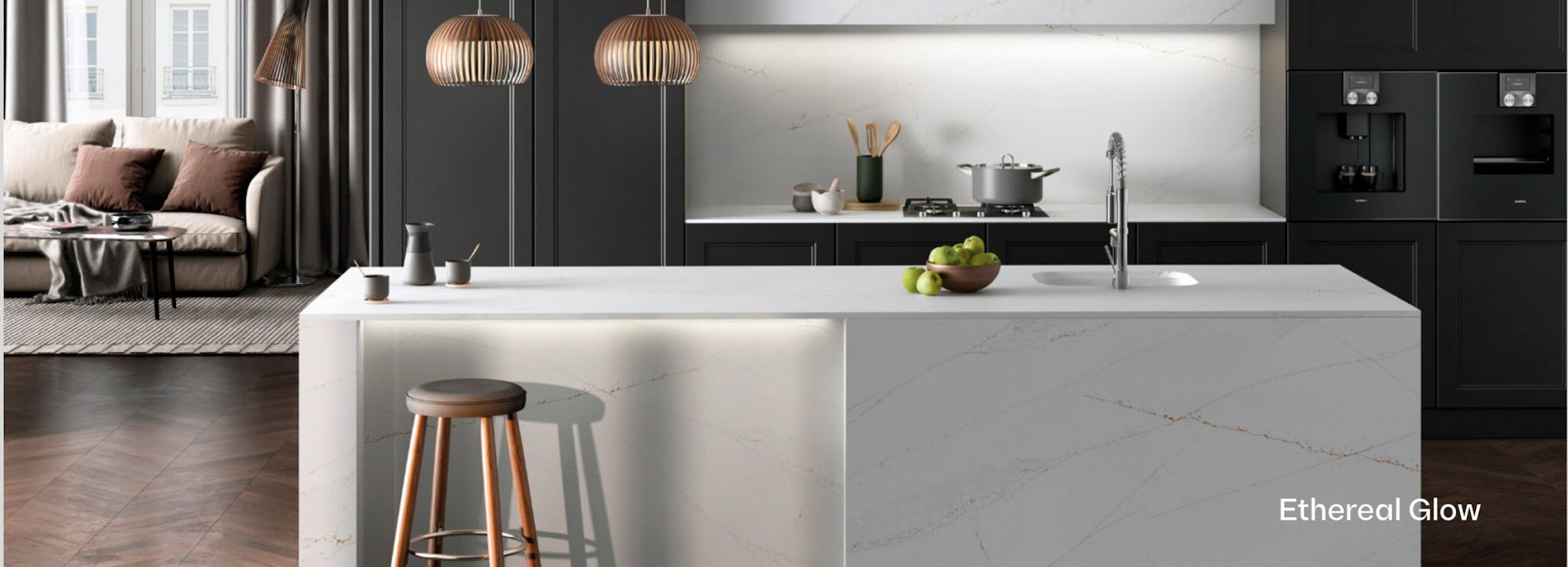
Images from Silestone Ethereal Series
Silestone quartz countertops are gaining popularity due to their remarkable durability, superior stain and scratch resistance, and low-maintenance properties. These countertops are known for their sleek and elegant designs, and they are available in a variety of finishes, patterns, and colors. In this blog, we will explore the advantages of Silestone quartz countertops.
1. Durability: Silestone quartz countertops are engineered to withstand heavy wear and tear over the years. Made from natural quartz, they are harder and sturdier than most other countertop surfaces, making it virtually impossible to scratch or chip them. Moreover, they have zero porosity which makes them resistant to stains, and they are also resistant to heat, so you don’t have to worry about placing hot pots and pans on your countertop.
2. Low-maintenance: One of the best advantages of Silestone quartz countertops is that they are entirely easy to maintain. Unlike natural stone and wood, you don’t have to pour oil or sealant on them to prevent them from getting damaged. Silestone quartz countertops merely need to be wiped with a damp cloth to keep them looking as good as new.
3. Variety: Another benefit is the broad range of finishes, colors, and patterns that are available in Silestone quartz countertops. You can choose between a sleek, polished finish or a more natural matte finish that mimics the appearance of marble or granite. Furthermore, Silestone comes in a variety of vibrant colors and patterns that can make a bold statement or provide a subtle look, depending on your preference.

Polished

Suede
Images from Silestone Finishes and Textures
4. Eco-friendly: Another benefit of Silestone quartz countertops is that it is made from sustainably sourced materials that are safe for the environment. The material used in manufacturing the countertops does not emit volatile organic compounds (VOCs) that can cause pollution or harmful health effects.
To round up, Silestone quartz countertops are an excellent choice for anyone looking for a low-maintenance, durable, and stunning countertop surface that adds value to their home. With a variety of colors, patterns, and finishes to choose from, homeowners can customize their countertops to match their creative vision and style. With Silestone quartz countertops, you get a durable, low-maintenance, and eco-friendly product that will transform your kitchen or bathroom.
VS.
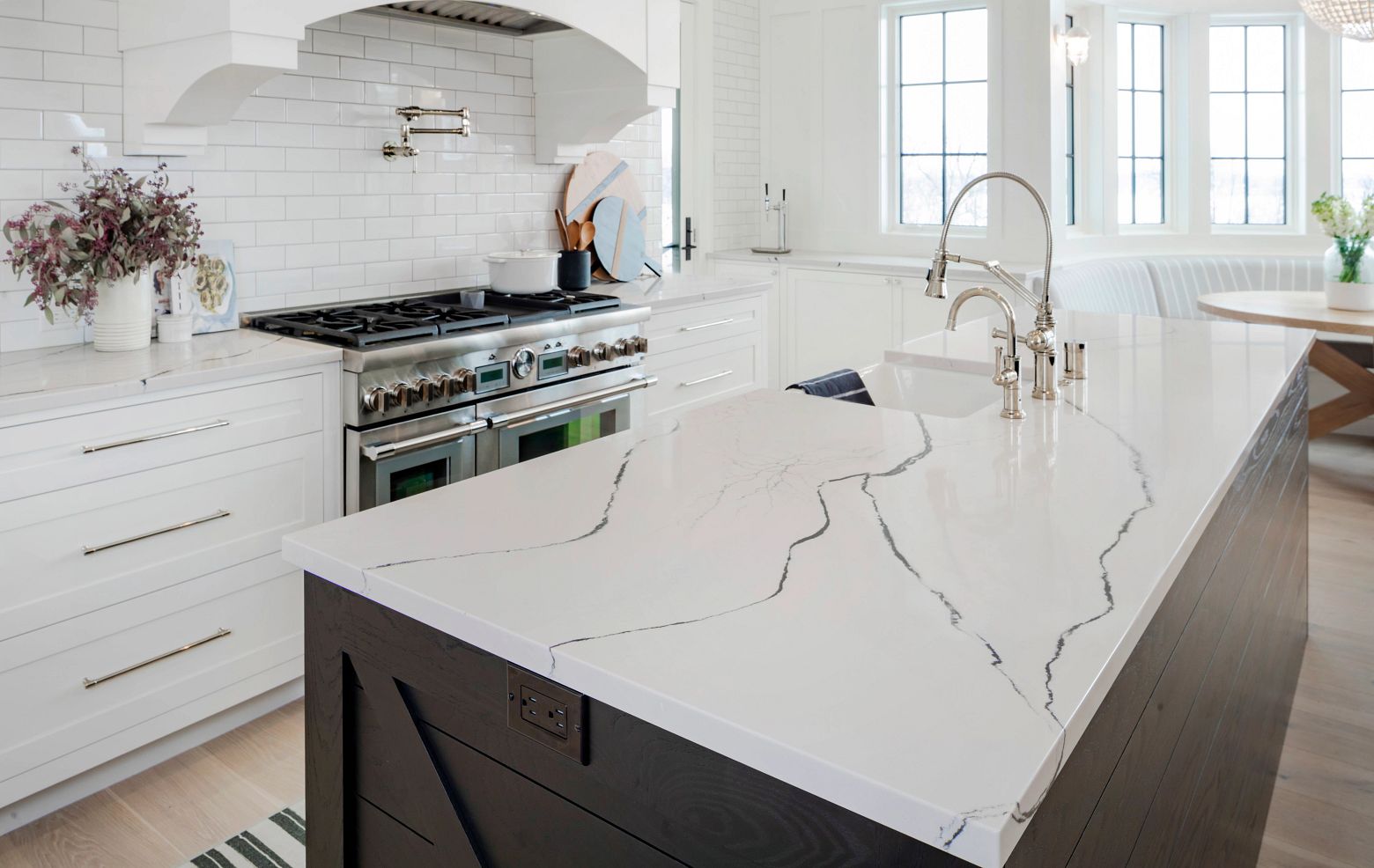
Image from Cambria Inspiration Images
Cambria quartz countertops are quickly becoming one of the most popular choices for homeowners when it comes to kitchen and bathroom renovations. This is due to the numerous advantages they offer over other countertop materials such as granite and marble. In this blog post, we will explore the advantages of Cambria quartz countertops in detail.
1. Durability: Cambria quartz countertops are extremely durable and can withstand heavy use and abuse without showing any signs of wear and tear. This is because they are made of 93% natural quartz, which is one of the hardest materials on earth, and 7% resin binder. This combination makes Cambria quartz countertops highly resistant to scratches, stains, and chip
2. Low Maintenance: Cambria quartz countertops are very easy to maintain. They do not require any sealing, polishing or reconditioning, unlike natural stone countertops. All you need to do is clean them regularly with a mild soap and water solution to keep them looking like new.
3. Variety of Colors and Patterns: Cambria quartz countertops are available in a wide variety of colors and patterns, making it easy to find the perfect match for your home’s decor. They can mimic the look of natural stone or come in unique and vibrant colors that can give your kitchen or bathroom a modern and sleek look.
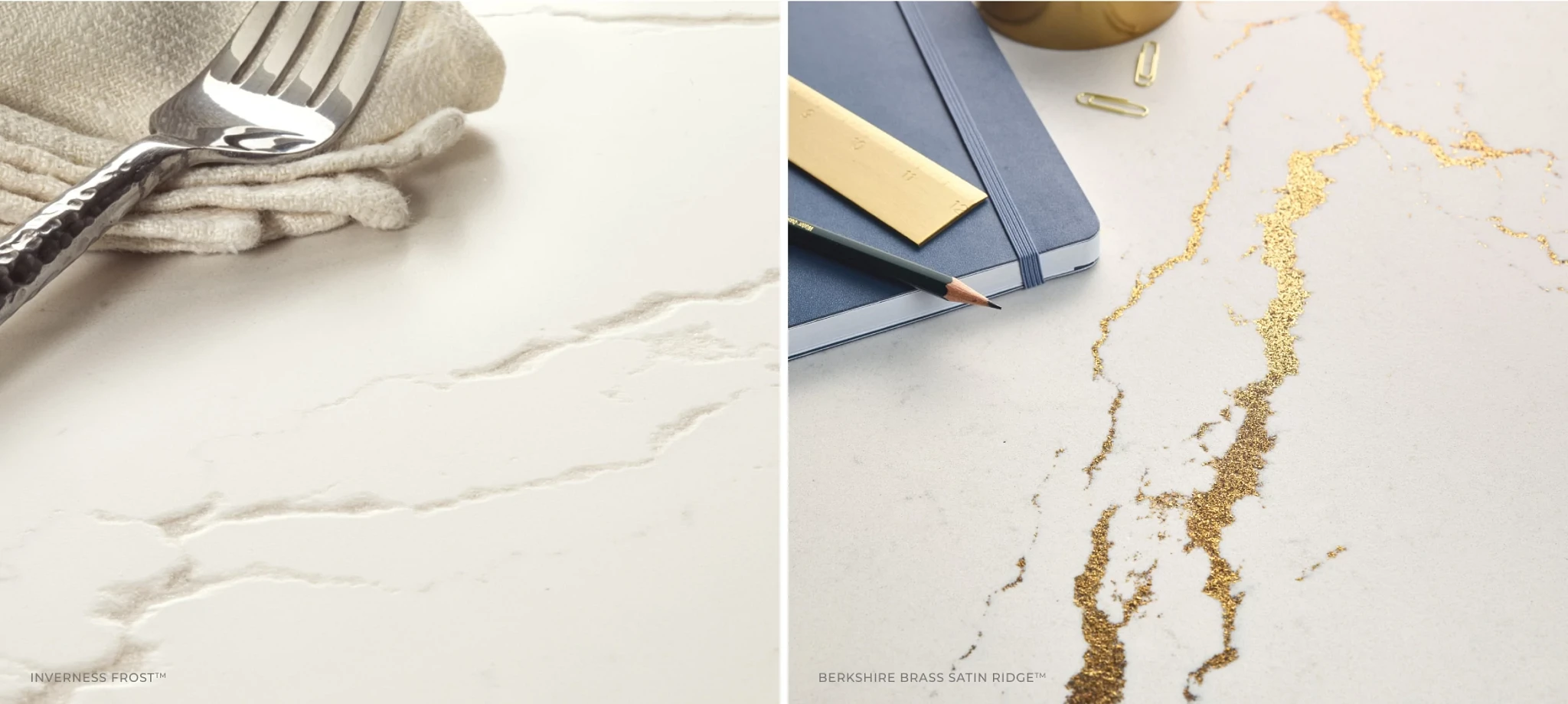
Image from Cambria Finishes and Textures
4. Safe for Food Preparation: Cambria quartz countertops are non-porous, which means that they do not harbor bacteria, making them safe for food preparation. They are also NSF certified, which is a standard of safety and quality recognized by the National Sanitation Foundation.
5. Environmentally Friendly: Cambria quartz countertops are an environmentally friendly choice as they are made using sustainable manufacturing processes and contain recycled materials. They are also Greenguard Gold certified, meaning they emit low levels of volatile organic compounds (VOCs) which can be harmful to indoor air quality.
6. Longevity: Cambria quartz countertops come with a lifetime warranty, which is a testament to their durability and longevity. This means that you can be assured that your investment will last for many years to come, making it a great long-term investment.
In conclusion, Cambria quartz countertops are an excellent choice for homeowners who want a durable, low-maintenance, and stylish countertop option. With their wide variety of colors and patterns, they can fit into any home decor and provide a safe and sanitary surface for food preparation. Additionally, their environmental friendliness and long warranty make them an excellent long-term investment.
Brighten Up! How to Coordinate Your Kitchen with White Cabinets
White cabinets are a classic option for kitchen design and are very popular. They not only increase the size of a small kitchen and brighten any room, but they can also give a larger kitchen a more unified appearance. White cabinetry adds a sophisticated dimension to your new or remodeled kitchen project. It is cheerful and upbeat. White in the kitchen is a favorite of creative designers because it gives small touches of creativity a chance to shine.
The question is, how do you match them up with the rest of your kitchen? Here are a few simple tips.
Pros and Cons
White cabinets have the advantage of making even the smallest spaces feel larger and more open. Regardless of your preferred style or trend, let’s not forget the clean, classic look. When combined with the ideal countertop, backsplash, and flooring, white cabinets can serve as a unified, polished anchor in small to large kitchen spaces.
Of course, there are a few drawbacks to a kitchen that is predominantly white that should be taken into account. Working with a trained kitchen remodeling contractor in Austin, Dallas, or wherever you are, is a great idea because, for example, a white-washed kitchen might come off as cold, harsh, or just unwelcoming! Invest in quality custom craftsmanship made by professionals in this field. Such kitchen cabinets come with a lot of options to pick from. Their extensive selection of custom cabinetry options gives you limitless flexibility in terms of door styles, wood species, paint or stain choices, etc.
Don’t forget to incorporate your lifestyle into the design process as well. For the clumsy home cook, white cabinets might not be the best option. The same applies if having a kitchen that requires little maintenance is a top priority, as spills, drips, or an occasional spritz of cola, tomato sauce, or yellow mustard may eventually stain or change the color of white cabinetry.
Layers of shades of white
Mixing whites will help you look less sterile. The room might look flat if only one color is used. Instead, pick three or four different shades of white and apply them to various surfaces throughout the kitchen. This will give the room depth and interest throughout.
Avoid blending warm and cool whites when bringing in various shades of white. Cool tones appear bluer, while warm tones appear more yellow. The majority of paint retailers will display their warm and cool whites separately, making it easier for you to locate whites that belong to the same category.
Pick the appropriate color of paint
When choosing a paint color for your walls, white cabinets will reflect light and may appear brighter than other colors. For walls next to white cabinets, light blues, greens, and grays are all excellent choices.
With dark accents, you can also add contrast. Along with having light colors in the kitchen to go with the white cabinets, contrast should also be added. Dark accents can help the room feel more interesting and deep. Examples include black cabinet hardware or a black granite countertop.
Make Use of Natural Lighting
A white kitchen benefits greatly from natural light from windows or skylights because it enhances the light and airy atmosphere you were going for in the first place.
The large set of windows above the sink allows plenty of light to filter in throughout the day, which is why this white kitchen gets better. Glass fronts on the upper cabinets magnify the light. This design element makes use of all that light by reflecting it throughout the area and into nearby rooms.
Tip: Window coverings in adjacent rooms can also make a difference. Use shades that can be fully raised during the day if you want to. Even more natural light will enter your kitchen as a result of this.
Materials
Use counters with light colors. Another key component of the kitchen that can work with white cabinets is the countertops. Light-colored countertops made of marble, quartz, or laminate will help to make the room appear bigger and more coordinated.
The use of complementary textures is another option. When choosing kitchen accessories, try to use textures that go well together. A difference can also be made by joining rooms. Use shades that can be fully raised during the day if you want to. Even more natural light will enter your kitchen as a result of this.
White kitchen cabinets are simple to maintain, making them ideal for families with active children. They’re a great option if you want to modernize your house.
Designer Insights: 12 Steps to a Typical Kitchen Remodel Process

Designer Insights: 12 Steps to a Typical Kitchen Remodel Process
The prospect of a new and improved kitchen is an exciting one, but taking the plunge isn’t always an easy decision. Our team at Bath + Kitchen, Washington, DC created this overview to help our clients understand what a typical kitchen remodeling process looks like based on our experience as a full-service design-remodel firm and authorized Dura Supreme Cabinetry Showroom.

Aside from the investment and inconvenience, two of the top fears around kitchen remodels are the fear of disappointment and the fear of being misled by a contractor. I believe these concerns should not hold you back from creating the kitchen of your dreams. Instead, I recommend doing your homework and learning as much as you can about the kitchen design process. When you understand the workflow, you will be in a position to collaborate successfully with your contractor and understand what’s happening at every step of your kitchen’s transformation.
See this video for a great example of a kitchen remodel project by Bath Plus Kitchen.
Step 1: Set goals for your remodel
What are you hoping to achieve through this kitchen remodeling project? Here are a few goals our clients often share with us:
- Creating a kitchen that suits their lifestyle
- Increasing resale value
- Incorporating smart appliances to create a more future-friendly kitchen
- Improving functionality, so home-cooked meals become an inviting option
- Updating the space’s look, especially for older kitchens
Defining a goal will help you share your vision more clearly with your kitchen remodeling contractor. It helps to write it out as a goal statement and share it with everyone involved. You can then revisit the document at every step to ensure you’re on track and making choices in line with your vision. Very often, the remodel is planned with a big event on the horizon. For example, one of our clients in NW Washington, DC wanted theirs completed before their baby boy was born. We completed this kitchen remodel project with them in 8 weeks, just a few weeks before they welcomed the newest member of their family home.

Dura Supreme Kitchen design by Bath Plus Kitchen
Step 2: Evaluate your existing kitchen
With a clear goal in mind, you can approach your Dura Supreme kitchen designer and together you can evaluate your goals and your existing kitchen. If you’re not sure how to evaluate them, start with these questions. At the Bath Plus Kitchen showroom, our selection process is a curated one that’s designed to ensure each project is a good match for the homeowner and the designer. If you explain your goals clearly, it will be easier for the designer to tell you if they will be able to execute the project to your satisfaction and budget.

Once you have identified your kitchen remodel team, you will need to work with them to assess your current kitchen. The aesthetics are the first thing to evaluate. Ask yourself what you love about it and what you want to change. In addition, consider these factors:
- Space – do you have enough counter, cabinet, and floor space?
- Flow – is it easy to navigate, cook with family members, and interact with guests?
- Appliances – should you upgrade to energy-saving, easier-to-use appliances?
- Accessibility – can family members of various ages and use it safely, including yourself as you get older? What about people with disabilities?
- Children and pets – do you need to make any special provisions for them?
Step 3: Design your dream kitchen
With a clear vision of your future kitchen, you can proceed to the fun part – designing! Yes, you will need to be realistic, stick to your budget, and make adjustments for any limiting factors, but a good kitchen designer can help you find creative solutions to give you a kitchen you will fall in love with. It’s important to be flexible and open to new possibilities during the kitchen design process. However, you should also stand firm on what you really want. For example, what kind of layout works for you? If you’re not sure what your options are, explore the pros and cons of some tried-and-true kitchen design layouts.
At our Bath Plus Kitchen showroom, I like to set up a meeting with prospective clients at this point. Prior to the initial visit, we ask our clients to email us the following:
- Photos of the current kitchen.
- Inspirational photos and/or a summary of goals and design aesthetic.
- Rough measurements and/or a sketch of the existing kitchen.

During this initial appointment, clients will be able to:
- Meet and interview one of our designers to explain the project goals, learn how we work, and determine if we’re the best fit for the project.
- Touch, feel, see our cabinetry displays and samples. Our Dura Supreme Showroom features two kitchens and a remodeled bathroom to showcase our level of design and craftsmanship.
- Settle on a rough budget for the project, depending on the size, scope, and level of materials required.
Once this is done, my designers go on to prepare plans for the job that include photo-realistic renderings for our clients. It’s a critical step because it will give you a clear picture of the kitchen you are planning.

Dura Supreme Cabinetry design by Bath Plus Kitchen
Step 4: Select your materials
Material selection is an integral part of the kitchen remodeling process. During this step, you will need to select materials that are functional, aesthetically pleasing, and that will suit your budget. Remember that this is an investment, and cutting corners here can make you unhappy with the final outcome. It’s essential to think long-term when it comes to choosing your flooring, appliances, cabinets, light fixtures, countertops, backsplash, and other kitchen elements.
That said, there are several incredible options to choose from that will suit your budget and needs. The Bath Plus Kitchen experts believe that kitchen cabinetry can make or break a kitchen design, which is why we offer fully custom and semi-custom cabinets from a top-rated manufacturer, like Dura Supreme Cabinetry. For example, many of our clients love the versatility of the Dura Supreme cabinets that we help them customize.

Dura Supreme Cabinetry shown in the Kips door style with the “Flint” Matte Foil and the Dash door style in the “Lodge Oak” Textured TFL
Step 5: Apply for building permits
Once the kitchen design plans are drawn up, you will need to apply for building permits. I work with clients from Virginia, Maryland, and Washington, DC, and know that requirements vary based on location. That’s why it’s always best to consult your local permitting office to ensure there are no oversights and potential code violations. Your designer can help provide you with advice and help you with this process.

Dura Supreme Cabinetry design by Bath Plus Kitchen
Step 6: Complete the demolition and re-evaluate
Here’s where the real work begins. Your remodeling team will start to remove your existing kitchen – floors, cabinets, appliances, and perhaps a few walls. A good team will minimize the mess and inconvenience, which will make a massive difference to you if you opt to live at home during this time. Once this is done, your team will inspect the kitchen to see if any adjustments need to be made due to unforeseen factors such as uneven floors and other construction flaws.

Flooring work in progress in a historic Washington DC home by Bath Plus Kitchen.
Step 7: Start the plumbing and rewiring (rough-in work)
This covers the framing, plumbing, and electrical work. At this stage of the kitchen remodeling process, the focus is on the walls of the kitchens and what goes into them. Since adherence to building codes is essential here, it’s important to let the professionals decide the best way forward. A professional inspection will happen once the work is done to ensure that your remodel is up to code so the project can continue.

A beautiful corner sink in a Dura Supreme kitchen designed by Bath Plus Kitchen
Step 8: Finish the walls, doors, and windows
Once you pass the inspection, you can complete the walls. This will entail hanging, taping, finishing, and priming drywalls. Doing a thorough job here will make the next steps of the kitchen remodeling process smooth sailing. After this, you can move to the doors and windows; finishing these will ensure your measurements for the kitchen cabinetry are correct.

Step 9: Complete the flooring
Contractors choose to do this at different points during the kitchen remodeling process. Some believe it works better if done after the cabinetry, while others recommend prior. We like to make a recommendation based on each project and its unique requirements. To decide on your flooring, look up a range of options for inspiration, from the classics to the trends.

Dura Supreme Cabinetry design by Bath Plus Kitchen
Step 10: Install the cabinetry, countertops, appliances, and fixtures
This is where things start getting exciting, as you begin to see your kitchen come to life! Those materials and elements you so carefully selected will be installed. Your new kitchen cabinets, countertops, kitchen appliances, plumbing, and electrical fixtures will all fall into place, allowing you to finally see your new and improved kitchen.

Dura Supreme Kitchen design by Bath Plus Kitchen
Step 11: Add the finishing touches
Once all the major tasks are completed, it’s a good idea to go back to your list and see what’s left. You can get these done and add the finishing touches. As mentioned earlier, the flooring may be put in last, so this last step will look a little different for different projects. I recommend taking the time to check all the little details before your contractor calls it a wrap.

Dura Supreme Cabinetry design by Bath Plus Kitchen
Step 12: Say hello to your new kitchen!
This is where you remember why you wanted a remodel in the first place! Step into your new kitchen and celebrate all the hard work and brilliant ideas that went into creating a space that you will love for many years to come.

Dura Supreme Cabinetry design by Bath Plus Kitchen
A kitchen remodeling project is a major undertaking. However, when well-executed, it offers you and your family a beautiful setting in which to make wonderful, priceless memories. That’s something I’ve enjoyed helping my clients experience throughout the years with the many kitchen remodeling projects throughout the Virginia, Washington DC, and Maryland tri-state area. Get in touch with your local Dura Supreme designer to start creating the kitchen of your dreams!

Credits:
Learn more about Bath Plus Kitchen at bathpluskitchen.com.
